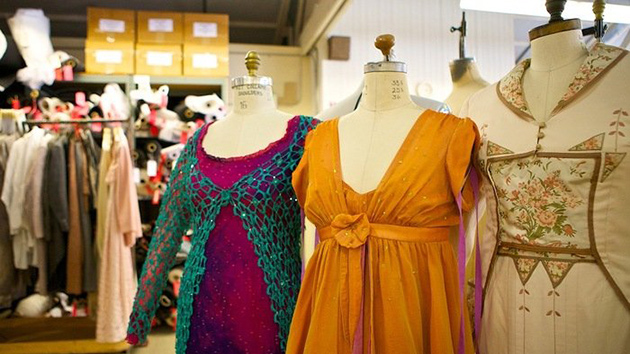
Mezzo-soprano Megan Marino is on the job in a conference room four floors above the War Memorial Opera House stage. Three other understudies for the Handel opera Partenope join her around a long table that’s dominated at one end by a huge flat-screen television transmitting the live action downstairs.
The quartet is about to watch the comedy of errors that director Christopher Alden has set in a 1920s Parisian salon. The opera’s two other understudies are elsewhere in the beaux arts-style structure, per San Francisco Opera’s company rule that, during a performance, understudies can be anywhere in the building, or five minutes away. The New York City-based Marino, whose credits include stints with the Metropolitan Opera, has watched Partenope rehearsals from the sidelines for weeks as a cover, the opera world’s term for an understudy. She’d had one run-through onstage with a rehearsal pianist along with the other covers before the rarely performed Baroque work opened its six-show run in mid-October.
Even before the curtain rises on this October 24 performance, the night of the World Series third game, it’s unlikely any of the covers will go on. One factor is that none of the primary singers in Partenope reported feeling unwell that morning during a routine wellness check. The odds are also low that any of the covers will go on for Partenope’s remaining two performances the following week.
Until the end of the opera’s third and last act, no one can know for sure. The only certainty is uncertainty.
Act I
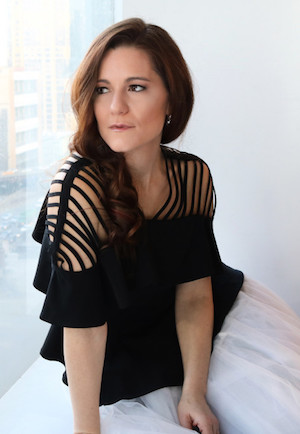
Before the curtain rises on Act 1, the action in the fourth-floor conference room centers around food. Marino, the cover for Daniela Mack as Rosmira, finishes her vegetarian takeout dinner. Countertenor Andrey Nemzer, who is covering David Daniels as Arsace, takes the last bites of a sandwich and then straightens his shirttails over his jeans. Soprano Stacey Tappan, the cover for Danielle de Niese as Partenope, pushes strands of dark hair away from her fine-featured face as she reaches past a bowl of pretzels for a tangerine on the table.
Missing from the group are baritone Hadleigh Adams (covering Phillipe Sly as Ormonte), who is in a practice room, and countertenor Ryan Belongie (covering Anthony Roth Costanzo as Armindo), who is seated inside the house. Tenor Andrew Bidlack, the cover for Alek Shrader as Emilio (and also René Barbera as Don Ramiro in the company’s production of La Cenerentola), makes a brief appearance in the room before leaving to be with his young family, who are visiting from their Baltimore home.
Tappan, Nemzer, and Marino are excited that tonight’s performance is being filmed in high-definition video, a format the company calls OperaVision. The three previous performances of Partenope they’d viewed in the room were filmed in wide shots, in which the singers look like tiny dolls viewed from the wrong end of an opera glass.
The high-definition video sets the stage for an evening during which the three singers watch the screen, mentally run through scenes, share some serious and lighthearted chats, and wait. While they didn’t know each other prior to being cast as covers in the production, they learn in “Six Degrees of Kevin Bacon”-fashion, ways in which they’re connected. The opera world, they all agree, is very small. The Russian born and raised Nemzer, it turns out, had done an opera with Marino’s current housemate.
In the eyes of the company and music staff, something was different. I’d stepped up to the plate. — soprano Daniella Mack
The trio zone in on small details the camera reveals that weren’t apparent to them while watching rehearsals from a row of chairs set up at the back of a practice room. Marino gazes intensely as Mack exchanges witty musical barbs with Shrader in the Noel Cowardesque production. “Were those grapes or olives in a martini glass?” wonders Marino, rocking her 5-foot-tall frame forward onto her UGG boots for a closer look.
Later the group discusses the quality and design of the costumes. Tappan and Marino are hot for the chic, sparkly tuxedo and other glamorous outfits de Niese wears as Partenope. “I got to try it on,” says Tappan, with a wide smile. “It was wonderful.” A second set of costumes weren’t created for the understudies.
“This is totally like watching a sporting event tonight,” says Marino, adjusting the Maria Callas-worthy headband of patterned gold thread holding back her upswept auburn hair. “Some people watch the World Series, we watch this.”
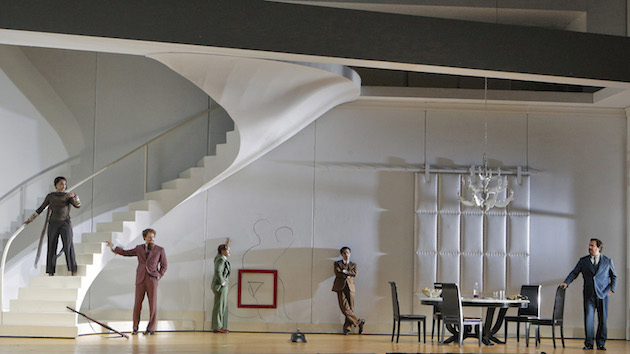
Intermission
It’s unlikely a cover will end up stepping into a role for many reasons, according to Gregory Henkel, director of artistic and music planning for the San Francisco Opera. Opera singers are driven to perform, they’re trained to sing under less than optimal vocal conditions, and they’re paid contractually per performance. The bigger the star, the bigger the pay.
“Singers cancel performances very rarely because they don’t get paid,” said Henkel, in a telephone interview a few days before the Oct. 24 Partenope show.
Historically, opera covers were a safety net for a singer who might fall ill or encounter other unforseeable circumstances. Some companies have a domino-like arrangement of casting where some players move to another role. Other companies, such as the Metropolitan Opera, now prefer to have on-call a large star to replace another large star in a role rather than have the role go to an unknown understudy.
At San Francisco Opera the use of covers for main roles is infrequent, according to Henkel. The reason is budgetary, he said: “We’re not able to afford understudies for every role any longer. It’s definitely a risk that we take.”
As a result, the company has put in several protocols as safeguards. “We’re a lot more sensitive to checking in with artists to make sure they're feeling well,” said Henkel. “Their health and happiness means the world to me.”
As a cover you’re kind of in this state of waiting. … If you don’t get a chance to perform, it’s disappointing but it’s part of the work. — tenor Alek Shrader
If it’s a widely performed operatic role, a singer is often brought in to fill in at the last moment, he said.
The company, as well, has a system of internal covers for supporting roles, many of whom are Adler Fellows, according to a spokesperson.
In the case of Partenope, all six roles required covers because the opera is rarely performed, and Henkel’s ability to find a singer on short notice who could take over a role in it was extremely limited, he said.
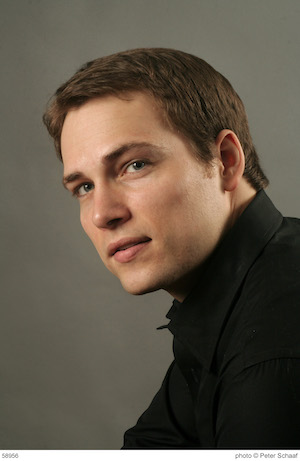
When choosing covers a couple of factors come into play for Henkel, who casts all singers in a production. It’s helpful to have an understudy who has sung the role in another theater. Bidlack, for example, had previously covered Emilio in a New York City Opera production of Partenope (and sung Don Ramiro with Omaha Opera and Intermountain Opera Bozeman). Tappan had previously covered the role of Partenope with Lyric Opera of Chicago.
The company may offer a covering opportunity because it is interested in growing a singer as an artist. Or, Henkel may decide to pick an artist the company is used to working with, maybe a company member. “You can trust them to go on and do the role,” he said.
Observers say it’s possible for understudies to receive a career boost if they’re called to step in. Critics hailed soprano Melody Moore’s debut in the San Francisco Opera’s 2012 production of Tosca when she was called in after the opera’s first act on opening night to take over for an ailing Angela Gheorghiu.
“Jumping into a performance like that can certainly put someone on the map,” said Henkel.
In 2008, Mack and Shrader, then Adler Fellows, stepped in for principal singers a few hours before a performance on two separate occasions. Shrader went on for Ramon Vargas as Nemorino in L’elisir d’amore. And Mack stepped in for Alice Coote in Mozart’s Idomeneo. Neither Mack nor Shrader, who married in 2011, remember much of their star turns onstage before taking a bow. The couple has had leading roles with the San Francisco Opera ever since, they said.
You do the job you’re offered. Sometimes you’re lucky enough to pick and choose. Sometimes you’re cast. And sometimes nothing happens for a while. That’s the business. — tenor Andrew Bidlack
“We took note that they handled the roles very professionally,” said Henkel.
“Certainly in the eyes of the company and music staff, something was different,” recalled Mack, in a telephone interview a few days before the final performances of Partenope. “I’d stepped up to the plate. In that way, it gave them a lot of confidence in me.”
Many young singers today perceive covering less as a possible career booster and more part of a path young artists travel in the course of building successful careers. The Partenope covers range in age from 29 to 41 years old.
“It’s a healthy progression,” said Shrader, in a telephone interview shortly before the two last Partenope shows in early November. “It’s sometimes dangerous for a student to assume they’re ready to perform without the vital time of cooking in the star-making chamber. That’s the way it is. We’ve all done that.”
“Every time I had the opportunity to cover, I was always honored,” said Mack. “It’s a huge part of what these programs offer young artists.”
Act II
A toilet is the centerpiece of the action in the second act and the antics onstage elicit laughter from the covers in the room four floors above.
As the merriment dies down, conversation shifts to what is the role of an understudy. And, if an understudy does go on, whether he or she should make the part their own.
For young singers the benefits of understudying include being paid to learn a role. “You earn enough to pay for some coaching, voice lessons, some on your student loans, and your opera addiction,” says Marino.
Another perk is the opportunity to watch and learn from master artists. “Some of the people I’ve covered I’ve got to coach with, including Natalie Dessay,” says Tappan, as she climbs onto the seat of her swivel chair to mark the Bob Fosse-like choreography de Niese is performing onstage.
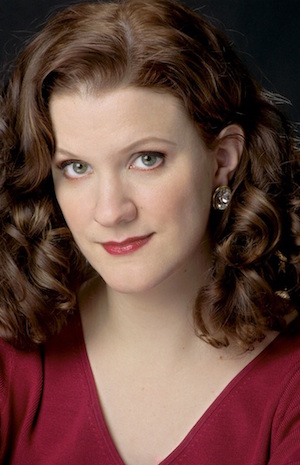
Tappan spent the first week of rehearsals in San Francisco filling in for de Niese, who hadn’t arrived yet when work began on the opera a month before it opened. Tappan had previously covered de Niese as Cleopatra in the 2007 Chicago Lyric Opera production of Giulio Cesare.
“I had questions and ideas [about the role] but I was always aware that she would come and take this over,” says Tappan. “I was a placeholder. I didn’t feel it was right to make it my own.”
“You keep your interpretation of it as close to the other’s interpretation,” adds Marino.
Tappan and Marino exchange thoughts about how principal performers might perceive their covers. “In rehearsals I’m always aware of the balance that needs to be struck because we’re support staff,” says Tappan. “We’re here to support them.”
“It can be an awkward thing,” says Marino. “It’s a delicate balance. Some think their covers are a little too eager.”
Tappan nods her head. “Some singers can get really paranoid about their covers watching,” she says, referencing the classic 1950 Bette Davis film about an actress and her understudy, All About Eve.
The two women agree that there’s little opportunity for divo or diva-like behavior toward understudies. Especially in the financial state the opera world is in today.
“I don’t think people can afford to be like that,” says Tappan, who has sung as a soloist with leading opera companies and regional opera houses. “It’s rare to find that now.”
Nemzer takes his eyes briefly off the screen to jump in, shifting his solid frame on the swivel chair. “This is my third experience covering,” says Nemzer, a winner of the 2012 Metropolitan Opera National Council Grand Finals. “I’ve covered David [Daniels] twice before and once for Anthony [Roth Constanzo]. I can’t say David and Anthony are crazy divos. They’re very nice and down to earth.”
“Because so many people have come up through the young artist programs, they know what it’s like to cover because they’ve been there,” says Tappan. “Some of my friends ask me, ‘Don’t you ever get jealous?’ I say, ‘No.’ You do this for the magic. It’s not about the glory. It’s a service to the art form.”
Intermission
Unlike rooms with storied pasts, the kinds of places you walk in to wishing that walls could talk, the fourth-floor conference room doesn’t look like it would have much to say.
With the exception of framed posters of past San Francisco Opera productions festooning three sides, and the industrial-size home entertainment set-up dominating the fourth, the room resembles more standard-issue corporate board room, with its long dark wooden table lined by black leather, high-back swivel chairs, than an opera star-making chamber.
The room only began being used as a gathering space for understudies several years earlier. During Shrader’s, Mack’s and Bidlack’s time as Adler Fellows in 2008, many understudies hung out in practice rooms in the building’s basement, where there were speakers. Sound was more important then than images.
“It’s like some sort of incubation tank for future stars,” said Shrader, of the fourth-floor room. “To be able to see what’s happening onstage is very helpful as well as to hear. As a cover you’re kind of in this state of waiting. You never hope it goes poorly for someone but you are prepared for the role and have done all the work. If you don’t get a chance to perform, it’s disappointing but it’s part of the work.”
Act III
As the opera starts to draw to a close the singers sit onstage during a cocktail party while the character of Emilio watches from the sidelines, taking it all in. On the fourth floor, Nemzer, Tappan, and Marino continue to sit and wait. Just in case.
“I don't feel a hope that I’ll go on but if I do go on, I hope to do well,” says Tappan.
Nemzer shakes his head. “I don't think about it. I’m coming here and doing my job. I don’t think about there’s no chance left,” he says. “There might be another chance, but not as a cover.”
Each of the trio stays prepared for their roles differently. “I’m a little type A,” says Marino. “I make sure every day to check in with my trouble spots, reviewing my notes on my score and walking around my make-believe mini set in my apartment.”
“I just do it in my head,” chimes in Tappan.
Hadleigh Adams, a New Zealand native and current Adler Fellow, who has been elsewhere in the building, joins the bonhomie in the room. Partenope is his first cover job. Most covers are in their thirties, he notes, and covering is part of the career trajectory of a young artist.
“I don’t think anyone would say ‘no’ to a cover job,” says Adams. “It’s work. Three things you ask yourself: Is it a role you want to play? Is it a company you want to work for? Is it a fee you want to work for?”
Like many young opera singers Andrew Bidlack, who will create the role of Rob Hall in the January 2015 Dallas Opera world premiere of Joby Talbot’s Everest, balances artistic opportunities. “You do the job you’re offered,” he said earlier in the evening. “Sometimes you’re lucky enough to pick and choose. Sometimes you’re cast. And sometimes nothing happens for a while. That’s the business.”
With the sound of applause in the background as cast curtain calls begin, the two men and two women in the room gather up their belongings and start to head out the door, exchanging pleasantries.
If there is any let down, it isn’t visible. As midnight nears, Adams hooks his arms behind the straps of his heavy backpack and pulls it on with a finality that marks the end of another night at the opera. He’ll be back at work the next morning at 9 a.m. His demanding schedule is a reminder of the resilience required of opera singers — as well as the fragility of their instrument.
Prior to that evening’s performance, Henkel recalled a San Francisco Opera production of The Magic Flute when the entire cast was “sick as dogs” with the flu. “Gockley and I got it,” he said, referring to David Gockley, the company's general director. “No one cancelled. They all gave very good performances. They’re trained to do that.”
The show went on.
“The show,” he said, “must indeed go on.”

